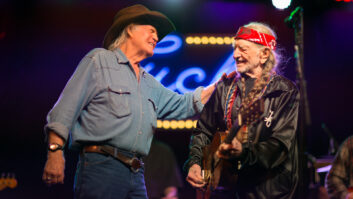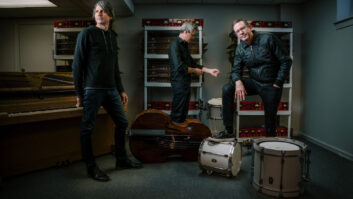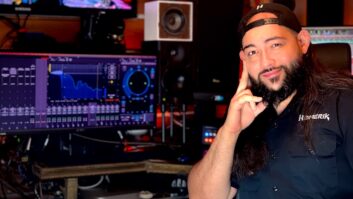Los Angeles, CA—You might imagine that, as frontman, principal songwriter and sole original member of Sum 41, Deryck Whibley would have better things to do than get into the weeds regarding the creation of the band’s latest album, Order in Decline. But as the producer, engineer and—for the first time—mixer of the project, which was recorded largely at his home studio in L.A.’s San Fernando Valley, he is more than happy to talk shop.
“I’m a nerd, man,” he says. “And all us gear nerds do is talk about recording and gear.”
During a 23-year career, Whibley and Sum 41 have worked with some of the best record-makers in the business. Not all musicians take an interest in the technical side, but Whibley was all ears from the get-go. “I’ve learned from everybody we’ve worked with,” he says, reeling off a list that includes Chris and Tom Lord-Alge, Ryan Hewitt, Jack Joseph Puig, Andy Wallace and the late Jerry Finn.

Sum 41 tours a lot. In the summer of 2018, the band came off a three-year jaunt promoting 2016’s 13 Voices ready for album number seven. While on the road, Whibley records demos on his laptop through a Universal Audio (UA) Apollo interface. Those tracks frequently make it to the final mix. Stepping off the tour bus, “I suddenly realized we had a bunch of stuff done,” he says, and it only took a few weeks to finish up the writing.
Whibley has been recording since age 16 in Toronto, when a friend of his band’s manager gave him some Sennheiser 421s, a couple of Neumann KM 184s and a 4-track machine. “I started recording all the bands around town,” he says, including two separate bands featuring Sum 41’s current guitarist, Dave Brownsound (Dave Baksh), and bass player Cone (Jason McCaslin). “I stole them and put them in my band,” he laughs. “That’s how Sum 41 was started.”
He’s been collecting gear ever since, piece by piece. “I’ve got 16 or 18 channels of Neve. I’ve got Telefunken V76, Helios, API and Chandler Abbey Road mic pres. I got Electrodynes halfway through this recording,” he says, after Ryan Hewitt recommended them. “He wasn’t wrong. They’re awesome.”
Studio Showcase: Fig, Spreng Bring a New Day to Dave’s Room, by Steve Harvey, Feb. 25, 2019
Whibley’s home facility, Studio Mr. Biz, has long housed his workstation and racks of outboard, but in the middle of making the new album, he learned that an SSL 4056 G+ desk was available. “I’d been looking for a couple of years and somebody I knew, producer David Bendeth, was getting rid of it. It was exactly the one I was looking for.”
It was the final piece of the Mr. Biz jigsaw puzzle. Like an area rug, “It ties the room together,” he says. The Desk Doctor—Bruce Millett—installed and recommissioned the console and is maintaining it.
Frank Zummo’s drums were tracked at EastWest, the band’s home away from home since 2002’s Jerry Finn-produced debut album, All Killer No Filler. “I can do drums at home if I want, but I really love going to EastWest. We did all the drums this time to tape and back into Pro Tools. Everything else was done in Pro Tools.”
Having played extensively with gear at his home, Whibley says he knows exactly what he wants to use when he records elsewhere. “I love [Neumann] M50s; there aren’t any other drum room mics that I love more. On the close mics, it’s [Sennheiser] 421s on the toms and a Shure 546 on the snare.” An AKG D12 captured the kick. “It sounds super punchy,” he says. The D12 was supplemented by a Shure Beta 52 and a Yamaha NS-10.
In Search of the Perfect Signal Chain, by Steve Harvey, Jan. 29, 2019
“We changed the overheads out a lot on this record to get different sounds for different types of songs. For the fast songs, we used [Telefunken] 251s. For the rock songs, we used Coles 4038s. And for the heavy rock songs, like the song ‘45,’ it was [Neumann] U67s. A good overall drum sound comes from the overheads, for me.”
At home for the overdubs, he continues, “I sing through a [Neumann] U47; that’s always been my vocal mic. Usually it would be a U47, [Neve] 1073 and an [UA] 1176, but this time I added a Neve 32264 on the front, then an 1176 ‘blue stripe’ right after it. Sometimes I would take the Neve out and just go with an LA3-A into the blue stripe. I also had a Pultec to boost a little 100 [Hz] and a little top, but it was always minimal amounts on the Neve and the Pultec.”
As for guitars, he continues, “I use a Sony C-37A for heavy guitars. That was a trick I learned from Doug McKean, a great engineer. He came in and did the drums with me on this record.”
Whibley had plenty of time to experiment at his home. He signed up to watch tutorials on Mix with the Masters and pureMix.net. “Those were really helpful. I would pick a song of my own and try mixing it seven different ways. I found that it always ended up the same. That’s when I realized that it doesn’t matter what you do, it’s your own ear that’s going to take you where you want to go, for better or for worse.”
Want more stories like this? Subscribe to our newsletter and get it delivered right to your inbox.
He assumed the album would eventually be mixed by a professional. “I was just doing what I was doing, printing everything as I wanted it to sound. By the end of it, I had to play stuff for management and the label. They wanted to hear what I’d been doing, because it had been three months. I made some rough mixes, and everyone came to hear it. They said, ‘Who mixed it?’ I told them, ‘I didn’t mix it. These are my roughs.’ They said, ‘This album is done! What are you talking about?’ A week later, Ted Jensen fit me in and it was mastered.”
Considering Whibley’s workflow, it makes sense. “When guitars went down, they came up on the SSL and went to Pro Tools fully EQ’ed and everything. I’d never felt confident enough to dive into compressing and EQ’ing that hard on the finished product going down to ‘tape’ as much as I did on this record. I really committed from the beginning—I was nervous while I was doing it, but when are you ever going to learn?” he says.
“Everything I did on this record, I wanted it to sound like it was mixed going down. There wasn’t much to do on the back end—so the way I mixed this album was by not mixing this album.”
Sum 41 • www.sum41.com







